#Release date: 1991
Photo





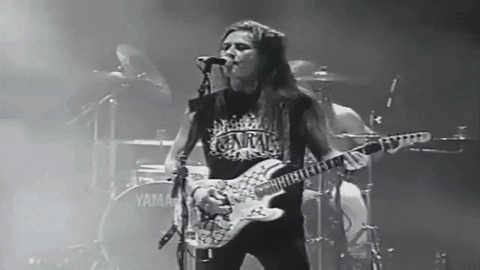
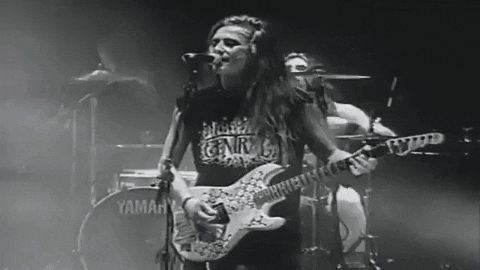

I'm the man in the box
Buried in my shit
Won't you come and save me, save me
Feed my eyes, can you sew them shut?
Jesus Christ, deny your maker
He who tries, will be wasted
Feed my eyes now you've sewn them shut
Alice In Chains - Man In The Box (Live at Moore Theatre) (1990)
#alice in chains#facelift#man in the box#Live at Moore Theatre#1990#Live Facelift#Filmed live on December 22nd 1990 at The Moore Theatre in Seattle Washington.#1991#Release date: 1991#Video#Genre: Heavy Metal/Grunge#Themes: Depression Drugs Suicide Death Pain Inner struggles#USA#my edit#my gif#b&w
87 notes
·
View notes
Text
listen. i love bruce springsteen. i love ethel cain. american teenager is not the new born to run. it is not born to run if it was written by a bi trans woman instead of a cis man. they are two very different songs in terms of sound and tone, and even theme-wise they run parallel to each other rather than down the same road.
a lot of ethel's music draws from/can be compared to a lot of bruce's songs, especially on his nebraska album, but i'm not seeing where people are getting the born to run comparisons from. if anything, american teenager reminds me of born in the usa if it was sung by the narrator's next-door-neighbor, a secondhand account of the suffering springsteen explores in first person in born in the usa.
also like. both of these songs can stand on their own just fine. a thing can be good on it's own without being compared to another thing.
#also another nitpick is just like#so many people being like 'american teenager is born to run updated for the modern age'#first of all#ethel cain's story as told in the album preacher's daughter#canonically takes place in 1991#it has a bit of a timeless energy#which brings me to the fact like#born to run is not out of date???#it has that timeless narration energy#and it's not even that culturally irrelevant#bruce sprinsteen released an album last year and is touring Right Now#they both sound timeless!#but ethel cain is her own artist with her own inspirations and idk#it feels kind of pandering to be like 'she's bruce springsteen but woke'#which is weird because it implies that springsteen was never revolutionary in his own sense#like he had an integrated band in the 70s! he regularly kissed a black man onstage! he plays with gender in a way that is interesting#and resonates with a lot of queer people#also it kind of feels insulting to ethel's artistry to go 'she's the trans version of [insert other artist here]!'#still not over the pitchfork review that was like 'what can ethel cain say that lana del rey hasn't already said'#like it just reduces her art to her being trans#instead of letting her music stand on its own#and while her gender identity is important#she is a good musician outside of that#and it's kind of insulting to her clear love for her art and her talent#to consolidate the value of her music to just her identity#ethel cain#bruce springsteen#born to run#preacher's daughter#american teenager
21 notes
·
View notes
Text
Queen - The Show Must Go On
1991
Innuendo is the fourteenth studio album by the British rockband Queen, released on 4 February 1991. It was the band's last album to be released in lead singer Freddie Mercury's lifetime. It reached the number 1 spot on the UK album charts for two weeks, and also peaked at number 1 in Italy, the Netherlands, Germany, and Switzerland, staying at the top for three weeks, four weeks, six weeks, and eight weeks, respectively. It was the first Queen album to go Gold in the US upon its release since The Works in 1984.
The album was recorded between March 1989 and November 1990. In the spring of 1987, Mercury had been diagnosed with AIDS, although he kept his illness a secret from the public and denied numerous media reports that he was seriously ill. The band and producers were aiming for a November or December release date in order to catch the crucial Christmas market, but Mercury's declining health meant that the release of the album did not take place until February. Nine months after the album was released, Mercury died of AIDS-derived bronchopneumonia.
"The Show Must Go On" was written by Brian May, based on a chord sequence he had been working on. May decided to use the sequence, and both he and Mercury decided the theme of the lyrics and wrote the first verse together. From then on May finished the lyrics, completed the vocal melody and wrote the bridge, inspired by Pachelbel's Canon. The song chronicles the effort of Mercury continuing to perform despite approaching the end of his life. When the band recorded the song in 1990, Mercury's condition had deteriorated to the point that May had concerns as to whether he was physically capable of singing it. May recalls; "I said, 'Fred, I don't know if this is going to be possible to sing.' And he went, 'I'll fucking do it, darling' — vodka down — and went in and killed it, completely lacerated that vocal".
The song was initially not released as a single as part of promotion for the Innuendo album, but was released in October 1991 as the band launched their Greatest Hits II album. The video for the song featured a compilation of clips from all their videos since 1982. Due to Mercury's critical health at the time of its production, a fresh appearance by the band in a video was not possible.
"The Show Must Go On" was released as a single in the UK on 14 October 1991, just six weeks before Mercury died. Following his death on 24 November 1991, the song re-entered the British charts and spent as many weeks in the top 75 (five) as it did upon its original release, initially reaching a peak of 16. In 1992, the song was released as a double A-side with "Bohemian Rhapsody" in the US and reached number 2 in the US.
It was first played live on 20 April 1992, during The Freddie Mercury Tribute Concert, performed by the three remaining members of Queen, with Elton John singing lead vocals and Black Sabbath guitarist Tony Iommi playing rhythm guitar. A different live version featuring Elton John on vocals later appeared on Queen's Greatest Hits III album.
Since its release, the song has appeared on television and film, including Moulin Rouge!.
"The Show Must Go On" received a total of 85,2% yes votes!
Previous Queen polls: #29 "Mustapha"
youtube
2K notes
·
View notes
Text
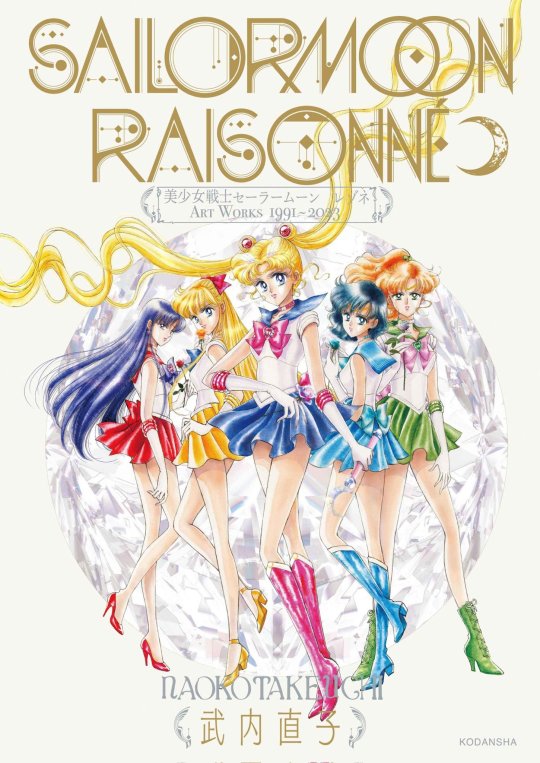
That Sailor Moon art book we were promised 100 years ago is finally getting released next month! This new release will collect 745 color illustrations from 1991 to 2023.
How exciting! It's weird they're announcing it just a few weeks before the release date. I'm a little apprehensive about the amount of art they're going to cram into a book. I think splitting it between two books would've been better. Oh well. Still exciting!
424 notes
·
View notes
Text
my two favorite valentine's day facts are that st. valentine is the patron saint of not only love but also beekeepers, people with epilepsy, and the plague, and also that february 14th is the original release date of the silence of the lambs (1991)
#am i religious? no. do i like to keep track of things that random saints are the patron of? yes#and no i have no idea who in hollywood looked at silence of the lambs and was like ah yes a heartwarming and romantic film let's drop it#pie says stuff#valentine's day
264 notes
·
View notes
Text


Only one date is ever mentioned in-game, that being 2021. Considering that the Virtual Singer Fan Festa seems to be a stand-in for Magical Mirai 2021, we can assume that the Scramble Fan FESTA! event takes place in September 2021 (the real-life MM2021 was delayed to November due to covid-19, but the pandemic doesn't exist in-universe and MM Tokyo usually takes place at the beginning of September). There are Leo/need Daily Life social media posts that show them attending Magical Mirai, and do state the year of the event, but these can be considered promotional material for the event itself rather than canon material, especially since the characters address in-game that only one year has passed since the start of the story (despite the fact they have celebrated new year's day 4 times now. Timeloop things).
Based on this date, we can actually place exactly when every main character was born. The cutoff date for Japanese schools is April 1st, making Ena the oldest main character, being a 3rd year with a birthday of April 30th, followed by Tsukasa on May 17th, so on so forth all the way down to Kohane, a 2nd year with a birthday of March 2nd.
Considering when Scramble Fan FESTA is set, Ena, who was a 2nd year at the time, would be 17 years old. That would place her date of birth as April 30th, 2004. Additionally, while Kohane, a first year at the time, should be 15 during the event, the game considers her to be 16 due to using a set age for every grade bracket. Regardless, the event setting places her date of birth as March 2nd, 2006.
Based on this, we can conclude that:
Ena, Tsukasa, Rui, and Shizuku were born in 2004
Mafuyu, Kanade, Airi, Minori, Saki, Toya, Nene, An, Ichika, Mizuki, Emu, Haruka, Honami, and Akito were born in 2005
Shiho and Kohane were born in 2006
This also means that Ena, Tsukasa and Rui are all older than the MEIKO software (released November 5th 2004), and everyone except Kohane is older than the KAITO software (released February 17th 2006). Every main character is older than Miku, the Kagamines, and Luka based on this information.
Using the information around set ages*, we can also work out rough estimates for when the side characters were born. For example, Arata, who was 19 during the first 3 years of the game, is 3 years older than the members of VBS who were all considered to be 16. Since the members of VBS were born in the April 2005 - April 2006 school year range, Arata was likely born in the 2002-2003 school year range.
* based on how characters like Youta and Miu, who are said to be the same age as Leo/need, were both confirmed to be 16 years old before the 3rd anniversary age-up. Also Haruka's age is confirmed as 16 at a point in time when she shouldn't be 16. Timeloop things.
Based on this, the oldest living side character, Kounosuke, who was 55 pre-3rd anniversary and 39 years older than Emu, was probably born between April 1966 and April 1st 1967. On the younger side of things, Hanano, who was 14 pre-3rd anni, was likely born between April of 2007 and 2008. I've put the rest of the estimated side character DOBs under the cut.
assumed age as of 3rd anniversary in brackets (literally just pre-age-up age + 1)
Rakunosuke Otori - April 2nd 1922 ~ April 1st 1923 (98 (at time of death. would be 100 if still alive))
Kounosuke Otori - April 2nd 1966 ~ April 1st 1967 (56)
Jean Riley - 1967~1968 (55)
Harumichi Aoyagi - 1968~1969 (54)
Shin'ei Shinonome - 1973~1974 (49)
Mr Yoisaki - 1975~1976 (47)
Ken Shiraishi - 1978~1979 (44)
Taiga Kotaki - 1978~1979 (44)
Yuuka Kazamatsuri - 1990~1991 (32)
Keisuke Otori - 1991~1992 (31)
Shousuke Otori - 1994~1995 (28)
Tatsuya Okazaki - 1999~2000 (23)
Ayaka Saito - 2001~2002 (21)
Hinata Otori - 2001~2002 (21)
Iori - 2002~2003 (20)
Mio - 2002~2003 (20)
Arata Tono - 2002~2003 (20)
Souma Miyata - 2002~2003 (20)
Kotaro Mita - 2004~2005 (18)
Sakurako Seiryuin - 2004~2005 (18)
Nanami "Nanamin" Hayakawa - 2004~2005 (18)
Futaba Natsuno - 2004~2005 (18)
Ayumi Tabata - 2004~2005 (18)
Hibiki Miyake - 2004~2005 (18)
Shuuta Hayashi - 2004~2005 (18)
Ibuki Taniyama - 2004~2005 (18)
Yuina Uchiyama - 2005~2006 (17)
Shouta Hayashi - 2005~2006 (17)
Miu Takagi - 2005~2006 (17)
Youta Yoshizaki - 2005~2006 (17)
Riho Hasegawa - 2005~2006 (17)
Saku Kousaka - 2005~2006 (17)
Mai - 2006~2007 (16)
Hanano Yoshizaki - 2007~2008 (15)
Ambiguous:
These ages were given in the 3rd fanbook, but there is not really any way to tell if these are the characters' ages at introduction or ages after the 3rd anniversary age-up. Here are both possible DOB ranges.
Mrs Asahina - 1980/81 or 1981/82 (41)
Yoshiki Shindou - 1982/83 or 1983/84 (39)
Yuuki Akiyama - 1999/2000 or 2000/01 (22)
Asahi Genbu - 2003/4 or 2004/5 (18)
Arisa Higure - 2004/5 or 2005/6 (17)
Additional notes (mod is rambling atp):
Rakunosuke died when he was 98 years old. In the WxS main story, Emu says that he died a year ago. Assuming Emu was 15 at the time, they have an age gap of around 83 years. The year of birth listed here was based on that assumption.
We know that Kanade's mother died aged 30, but we do not know when she died. She is still alive in flashbacks set roughly 10 years prior to the events of game.
We do not have confirmed ages for Nagi, Reki, Sakaki, MMJ's landlady or Mafuyu's father yet.
Rui suggests that Reki is the same age as him in A Story Where You Are The Star. However since it's more vague than Asahi, I left it out. However, Asahi was since confirmed as 18 when he was compared to Reki as being similar age, it is likely that Reki is also around 18 years old.
Nagi's age is left blank in the fanbook due to it not being revealed that she was dead at the time of publication. She is younger than Taiga, but we don't know by how much, but nonetheless she was likely born in the early 1980s.
No NPCs are given exact birthdays
#this post is an apology for the fact i never made a timeline when i said i would. sorry this is kinda confusing also#in short just know that we can assume that the game takes place in the 2021/2022 and 2022/2023 school years#don't use that as an excuse to be weird about the characters bc that's still the in-universe year(s) even if it's not the irl year.#this post is just for fun okay? okay.#project sekai#lore
348 notes
·
View notes
Text
Pt. 3/3: My BATDR Timeline & Plot Twist Theories!
First, I think both BATIM and BATDR take place sometime between 1978 and 1991. I already suspected BATDR was happening in the ‘80s based on the fact that card readers – which have featured in many of the environment screenshots we've seen – were invented in 1979...

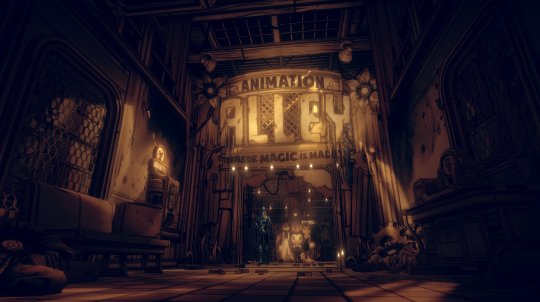
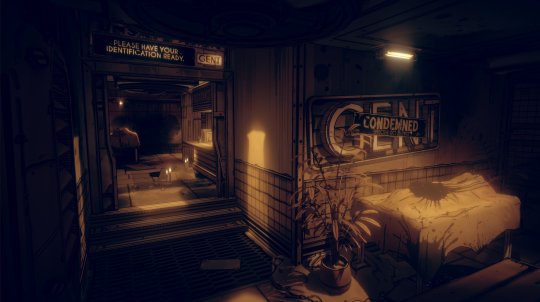
…and Audrey's clothes and hairstyle look very 1980s.

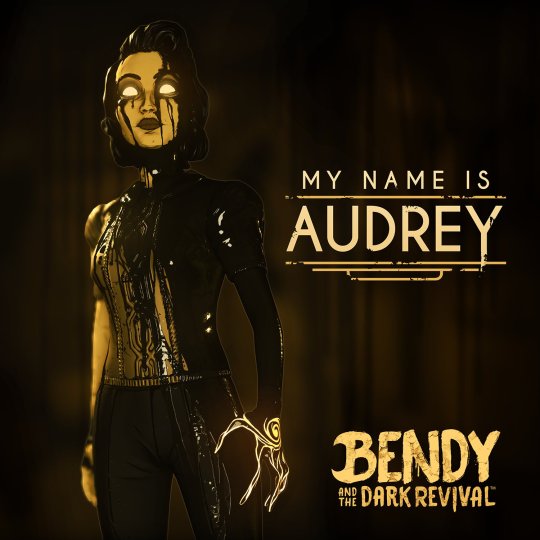

Then they released the images of Audrey's office, where her chair and desk lamps also look very 1980s, and the wallpaper and flooring looks pretty 1970s…




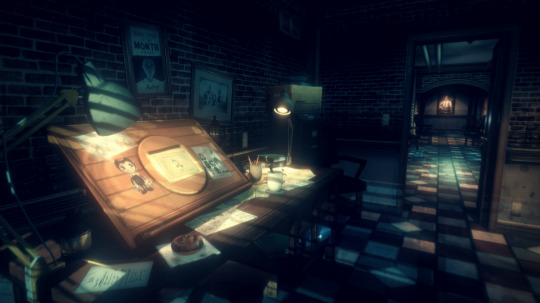
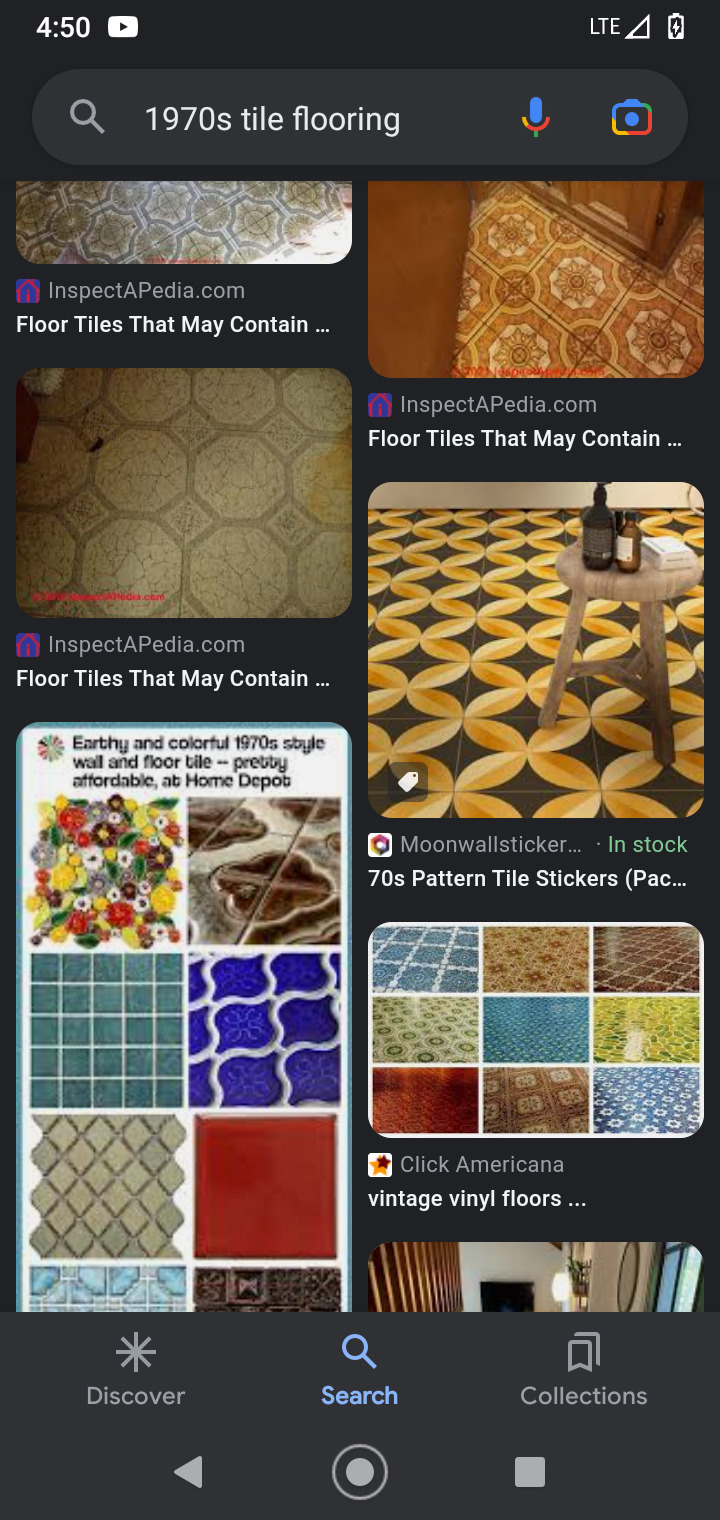
…and @inkdemonapologist pointed out that the type of bankruptcy we see documents for in Joey's apartment didn't exist until 1978…

…and I remembered that Joey's apartment also had a newspaper whose headline took place in the future— Princess Diana's 30th birthday which, as TetraBitGaming on YouTube pointed out, would be in 1991 since Princess Diana was born in 1961. She should be two years old if BATIM were really taking place in 1963!


Maybe, at the time, they didn't mean for these two to be clues, since they seem to have rolled the date backwards a bit from the newspaper one; but at this point it feels pretty clear when BATDR takes place, to me. And I'm even more certain than I already was, after finding out that this image from the JDS website…

…is titled “museum” (good work yoinking it, @halfusek /gen 👍🏻), that we know the ink dimension's new home: Nathan Arch Sr.'s private Joey Drew Studios museum that he mentioned he was curating in TIOL (meaning it's existed since around 1972).
“Over the years, I have collected every single piece of the studio memorabilia I could find to restore it to its former glory, to create, in a sense, a private museum that gleamed with the true vision of Joey Drew…” ~ Nathan Arch, The Illusion of Living, pg. 2
Also, besides the fact the museum image has clearly aged, here's some more evidence that at least a few years have probably passed since Bendy was purchased: it generally takes a fair bit more time (years!!) to make movies/documentaries, as Archgate Pictures seems to have made about Joey, than it does to make shorts.
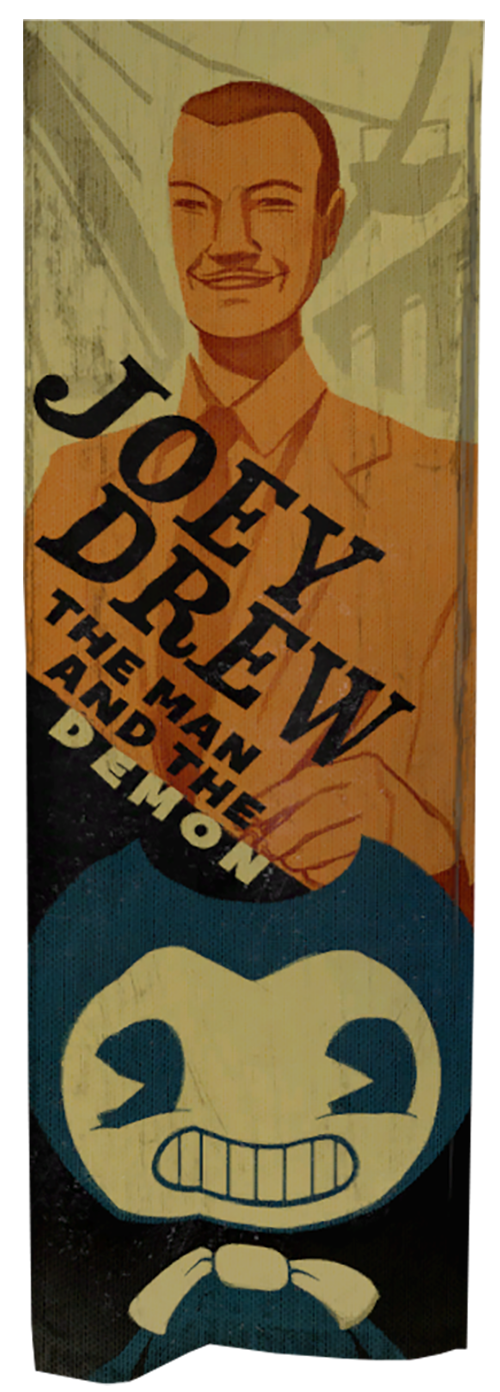
As for BATIM, I think that time has been moving as normal outside of the loop, we were just seeing a repeat of that significant day in 1963; Henry and Joey have been trapped in the ink dimension for somewhere between twenty and thirty years, and the bankruptcy paperwork and Princess Diana newspaper were pieces of the real world leaking into the memory. This explains how there seems to be evidence of Audrey in BATIM and how BATDR is still supposedly neither sequel nor prequel to BATIM despite all the evidence that it takes place long after 1963! They're happening at the same time!! I wonder if Audrey is the daughter of the little girl we hear at the end of BATIM? So, Henry's (great-)granddaughter or Joey's (great-)great-niece?
Now, onto my big theory: the plot twist.
If they handle it right, it would be really, really cool if “break the cycle” really doesn't just mean “end the time loop” but also “break the cycle of abuse/trauma” and a lot of the huge cast of not-so-innocent characters wind up with the potential to get redemption arcs. I have an idea of exactly how they might be planning on even providing the opportunity for Joey.
Victor McKnight commented this on his Artistic Hallowing music video and pinned it:

Those last two sentences. “Make sure you're watching every second! You don't want to miss any vital information. 😉” Does that not sound to anyone else like he's got insider information? Now, I want y'all to watch these music videos that either Victor himself or his brother Noah were suspiciously involved in all of (and one of which is supposedly a BATDS song but for some reason involves Audrey) and tell me if you notice any patterns.
youtube
This one seems to be a duet between Sammy and the Ink Demon, both singing to Audrey. Sammy mostly sings in the default sepiatone, asking us things like “Can you see me? Can you feel me?” (that feels so… sad… and desperate…) and telling us things like “make sense of the consequence we witnessed on that day” (Excuse me, you're telling me that there was a consequence for something on a specific, significant day that we witnessed?? 👀) The demon, on the other hand, mostly sings when the grayscale effect is on, and seems to just be playing a stereotypical villain roll until you notice “be forced to believe what I see” (why would we even give a crap about what you're seeing /srs? How the actual heck would we see what you're seeing /gen? You don't even have eyeballs, bro /j) and “be damned in this evil received” (how do you receive evil that damns you? Maybe by being abused and becoming an abuser in response?).
youtube
Two apparently-separate characters singing with the same voice but very different tones and outlooks on the situation, still both singing to Audrey, in this one. One mostly sings in the default sepiatone, again, at first seeming more hopeful, helpful, and friendly until you start noticing ominous comments like “you've made mistakes, accept the change. You will be punished too” (*incoherent noises* 🚨🚨) and “welcome to my dream . . . you still think you are safe in my dream.” The other mostly sings when the grayscale effect is on, again, and seems much more aggressive and seductive until you start noticing comments like “take up your weapons, just leave my friends be” (why is this stereotypically evil-seeming character both telling us to take up weapons, not just letting us have them, and asking us to leave his friends alone with them?).
youtube
More hints that the demon who will rise and presumably is most important to the story is linked to grayscale, in this one.
youtube
And, in this one, Sammy's asking if the grayscale-linked demon is the one who will set him free (as he claims to be in the first two videos).
Across all four of these first videos, there seems to be an overall “things change when we switch from the default sepiatone to grayscale” and “grayscale is dangerous and seems hopeless but it's important and linked to truth and freedom” theme…
youtube
…You're telling me that Sammy and his followers' past (BATIM?) selves were worshipping an imposter demon…? And the truth will be revealed in BATDR…?
Hum, hum, hum… fascinating. I'd noticed the sepiatone vs. grayscale split and imposter vs. true savior thing long before I read the books; for the longest time, I thought it meant we would be dealing with a Henry-Bendy and a Joey-Bendy, as I've been seeing people theorizing. But then I read TIOL, and discovered what I think is evidence that this info is indeed canon and was not left on the cutting room floor while BATDR was in development limbo.
Nathan makes a very strange note on Joey's story about the Sparkle Unicorn speakeasy…
“…I remember this night well. Though I remember it being at the Bee Room, gold and black, not silver as the main design aesthetic. Doesn't really make much of a difference though, I suppose.” ~ Nathan Arch, The Illusion of Living, pg. 44 (emphasis added)
Nathan remembers that night in sepiatone, Joey remembers it in grayscale.
Now, I've seen all kinds of theories all over about how Wilson actually “banished/killed the ink demon…” “Wilson took advantage of some sort of blip in Bendy's existence that happened when Joey died,” “Wilson got rid of him by purifying him and turning him into Dapper Bendy,” “Wilson got rid of him by fusing him with either Henry or Joey,” “Wilson got rid of him by trapping him in Henry's loop,” “he didn't, Wilson's just another liar manipulating everyone,” etc…
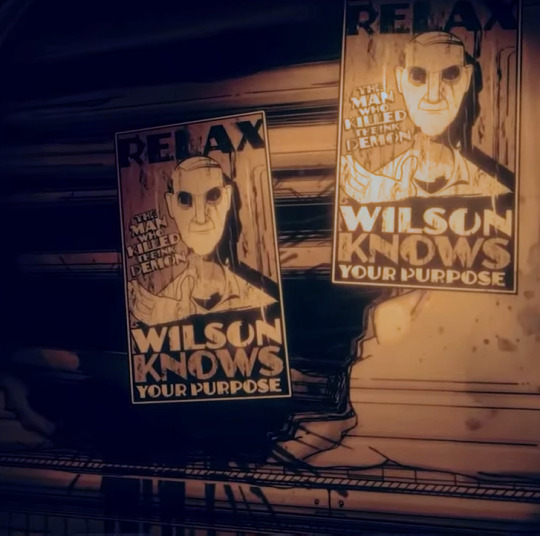
What if we're looking at this from the wrong angle? What if the point is that, whatever happened, neither of the BATDR Bendys is the original soulless monster we see in BATIM and the books? What if, whether they share a body or are separate, there are two human souls involved here? What if one of those souls is the “new evil” in the ink dimension, not Wilson, who may have been meddling in ink dimension affairs since 1963?

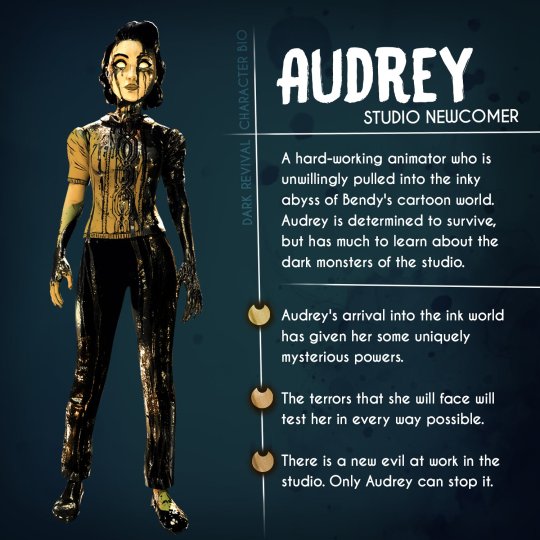

Going back to the time frame I propose BATDR is happening in… Joey was born in 1901, which means that if Nathan was 18 or 19 when Joey was just turning 16, then he was born in 1899 or 1898. So, in 1978, Nathan would've been 79 or 80, and in 1991 he would've been 92 or 93. Especially considering the clues that point towards Nathan having been a smoker, it wouldn't surprise me if he's straight-up already dead in BATDR. Mayhaps for 211 days? During Loop 414…? Could this be why the BATIM loop is different, with Henry apparently not remembering anything that previous versions of himself could? The now-previous owner of their prison has died of old age and/or lung cancer? And could that be why the JDS museum has fallen into bankruptcy? Has Nathan Jr. taken over and isn't as ruthless a businessman as his father?
Itsjustjord on YouTube pointed this out in his trailer reaction, which when he said it set my Clue Radar off so that I went to the trailer again to get a closer look. And… well… *clears throat*
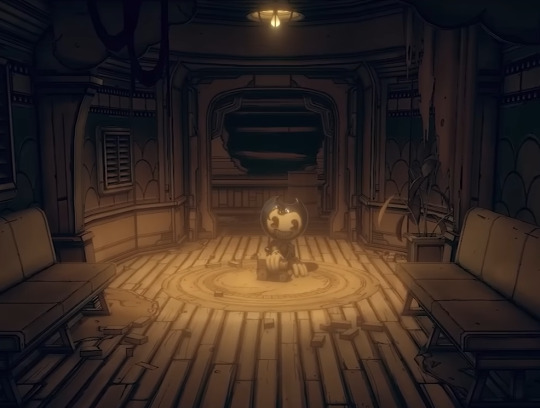
…Do y'all see this weird effect over Dapper Bendy? Compared to every other character we see in the trailer as well as the environment around him, does it not look as if we're seeing him, specifically, through some sort of cartoony filter? Maybe it'll only be in circumstances like this (far away in weird lighting) that the edges of the illusion will fray in-game, based on the other teaser image we have of him, but it definitely looks off to me.
Especially with what I now suspect Allison and Susie's situations were in relation to Nathan, I think that the ink creatures’ perfection vs. imperfection has nothing to do with how pure/good vs. impure/evil their hearts are as we've been lead to believe/is the conventional surface-level reading, but instead how intact vs. broken their hearts are. I think that the more horrific the ink being's appearance, the more the soul inside was abused while it was alive. Allison isn't a perfect Alice because she's a better person, it's because she obeyed Nathan and wasn't made to suffer as severely as Susie, who Nathan chose to be his next Isabel. So, why is one new Bendy (apparently created after Joey lost everything, I suspect even being made to watch his Shoulder Angel's murder before being murdered himself) so much scarier than the original (created before Joey lost everything) and the other so goshdarn perfect, proportions and all?
Maybe the banning of everything related to Sammy's demon cult and Henry under Wilson's rule has to do with his decades-old mission to keep the Creators from joining forces, as well as everyone including himself feeling like they're finally free from The Great Puppet Master?
I love Dapper Bendy's design as much as everyone else!! He's positively adorable, and it would also be a nice outcome if the baby boy is exactly what he seems and just a precious lil friend to love forever; but I theorize that Dapper Bendy is the perfectly sane, untraumatized, and truly evil one, that (assuming we actually get choices in BATDR, unlike in BATIM) his route, no matter how things seem in the moment, is the wrong one, that he's Nathan. And I think Freaky Teeth Bendy (that's been my nickname for him since we first saw him and I'm sticking to it lolol) is the damaged as heck but able to be saved one, that his route is the correct one, that he's Joey. I also think that we won't get to see either demon for what they really are – won't be able to get the True, Broken Cycle, “Joey's Redeemed & Nathan Faces Justice” Ending – unless we somehow unlock Grayscale Mode like we could in BATIM and gain the ability to see Joey's truth. Until then, we'll be seeing the demons the way Nathan wants us to see them. Through Nathan's tainted, gaslighting, sepiatone filter.
If I'm right, the fact that they did choose these color palettes is so perfectly poetic~! Sepiatone is what happens when black-and-white images have been chemically altered for preservation purposes; Nathan's altered our perception of himself, Joey, and all the events surrounding them, and his version of events is much more resilient. Meanwhile, Joey's would be more pure and unaltered but easily destroyed— including by himself, with his Illusion of Living coping mechanism… The only thing that could make it more perfect is if not only do we get to see Henry in BATDR, but when we do he's an angelic toon… *Vibrates with excitement*
Please, please, please, JDS, let me be right about where you're going with this!! Cause this would genuinely be so freaking cool…!! 🙏🏻 I hope that we eventually get to “rejoice with our founders,” as Artistic Hallowing says, when they're reunited.
Thank you for coming to my TED Talk, rofl. Congratulations on making it through the ramblings of a hyped AuDHD fangirl (though, I guess we already knew you were capable, if you've read TIOL. I could do a whole nother rant on evidence that Joey's basically confirmed canonically ADHD(+?), my freaking gosh). 😝
Read the Rest of the Original Analysis/Theory: Part One • Part Two • Unexpected Part Four
BATDR Analysis/Post-Playthrough Theory Revision: Part One • Part Two • Part Three • Part Four
#long post#spoiler warning#book analysis#game analysis#book theory#game theory#bendy and the ink machine#batim#dreams come to life#dctl#the illusion of living#tiol#crack up comics#bendy: the lost ones#bendy: tlo#bendy and the dark revival#batdr#batdr trailer#batdr theory#joey drew#nathan arch#henry stein#allison pendle#thomas connor#wally franks#bertrum piedmont#sammy lawrence#tw: abuse
823 notes
·
View notes
Note
just saw your post about how Golden Sun is on the switch now. would you be cool with telling us more about it?
(i struggle to get into media that is new to me without knowing a bit about it first, and it's usually best when i hear it from someone who loves the media in question)
Golden Sun began as a two-part Game Boy Advance JRPG series starting with 2001's "Golden Sun" and ending the first arc with "Golden Sun: The Lost Age" in 2002. The second arc of the story began with "Golden Sun: Dark Dawn" on the Nintendo DS released in 2010 and is the last title in the series to this date with an unfortunate "The End?" cliffhanger suggesting the closure of the series as a whole would come with a FOURTH game to be released at some point in time. To this day there has been no true word on a fourth title to finally finish the series.
The Golden Sun series of games were developed by Camelot Software whom originally were a Sega Only Developer specifically focusing on the "Shining" series starting with Shining in the Darkness in 1991 and ending with Shining Force III in 1998.
Camelot Software then became a Second-Party Development Studio for Nintendo focusing on the Mario Sports series of titles including both the home console and handheld versions of these games, beginning with Mario Golf in 1999.
Camelot Software was also the creator of the Waluigi character who first appeared in Mario Tennis in 2000. (They also created both the UNSEEN version and now KNOWN versions of Wapeach for Mario Tennis and Power Tennis respectively.)
The game series was created with the intent of allowing Camelot to get back to their roots or more RPG style games and to bolster the Nintendo IP owned roster with diverse gameplay titles. Much of Golden Sun's style can be seen in Camelot's older "Shining" titles with a more evolved and "of the era" style. Golden Sun was originally being conceived as a Nintendo 64 title before it was revealed that the Game Cube would be releasing soon and the N64 would be sunset. Development then moved to the GBA.
Originally Golden Sun and The Lost Age were intended to be ONE GAME, but the cartridge space on the GBA was too small and would need far more memory to whole the full game so the idea to split it in two was devised to create a much more well rounded story, give devs more time to finish the latter half of the game, and get the first title out sooner.
Golden Sun (as a series) is fairly simple and follows more traditional JRPG standards of turn based battles, a party of four characters, elemental magic, leveling up, and various collectable armors and creatures to enhance characters in and out of battle.
Elements are a key point to both gameplay and story as the world is inhabited by a small amount of "Adepts" whom can control these elements based on four types: Wind, Earth, Fire, and Water.
Djinni, small elemental creatures, can be found all over the world that will add new abilities and skills to the party's Psynergy (the game equivalent of magic spells) as well as used as parts of larger summons.
The main plot of the first title follows Isaac and Garet, years after the tragic loss of Isaac's father and their mutual friend Jenna's brother and parents being killed in a storm, as they learn more about their town, the world around them, psynergy, and the history of Mt Aleph's Sol Sanctum (a temple hidden within mountain near their small village) from one of the village's historians Kraden.
After opening up Sol Sanctum they are approached by two people who were part of the cause that ended up taking the lives of Isaac's dad and Jenna's family, a third masked figure, and their presumed fourth partner who are currently hunting for the Elemental Stars in an effort to light all the Elemental Lighthouses and releasing the power of Alchemy and Psynergy (again, the game's magic system) across the world which could be potentially disastrous.
After most of the Elemental Stars are stolen, Jenna and their teacher Kraden are kidnapped, Garet and Isaac meet "The Wise One" (a giant floating rock with an eyeball) who tasks them to stop the opposing party of four before they can attain their goal and quite possibly doom the world.
Along this journey they are eventually joined by Ivan, a young Wind Adept, and Mia an expert healer and Water Adept. Between these two and Isaac, an Earth Adept, and Garet, a Fire Adept, the party is able to round out with the full elemental psynergy roster.
They end the first game with a cliff hanger that directly and immediately starts back up with Golden Sun: The Lost Age.
The Lost Age features 4 new party members, who you do meet some of in the first game (no spoilers), and eventually the two teams of four merge into a team of 8 (two of each elemental type) - the groups combine their powers and the first arc ends.
Dark Dawn, the DS title, takes place 30 years after the end of The Lost Age and primarily follows around the children of the protagonists from the first two games going on an adventure that started far before their birth with something that happened at the end of The Lost Age.
Each game features both in and out of combat use of Psynergy. For combat it's as simple as attack/defend/buff/heal/etc. Outside of combat certain elements of Psynergy are used to solve puzzles in various ways from growing plants, pushing large stones, reading character's minds, blowing away objects with great winds, freezing water to create new platforms, etc.
The game features lots of fun collectables, side-quests, world building events, optional dungeons, and more.
I could go on and on about this series more, but that would involve a TON of spoilers so like... GO PLAY THE GAMES! THEY ARE VERY FUN!
65 notes
·
View notes
Text
Korean studio D-ZARD developing new Princess Maker game starring Karen
Gematsu Source
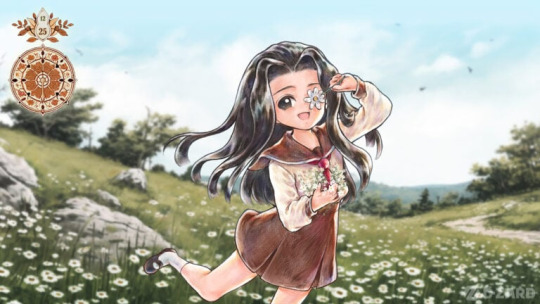
Korean studio D-ZARD is currently developing a new entry in the Princess Maker series under a licensing agreement with intellectual property owner YONAGO GAINAX, the company announced. Platforms and a release date were not announced.
The new title will incorporate Live2D animation and aims to be a project that appeals to both long-time Princess Maker fans and newcomers alike.
Get the first details below.
About the Series
The Princess Maker series, which was wildly popular in the 90s, helped define and popularize the raising simulation genre. The first game in the series was released by GAINAX on PC in 1991 and was a global hit, eventually spawning four sequels.
Meet Karen, the Daughter
The main character of the new game is Karen, whom many fans have rooted for to get her own game. Players will be able to see her appearance change as she grows up.
—Daughter’s Room
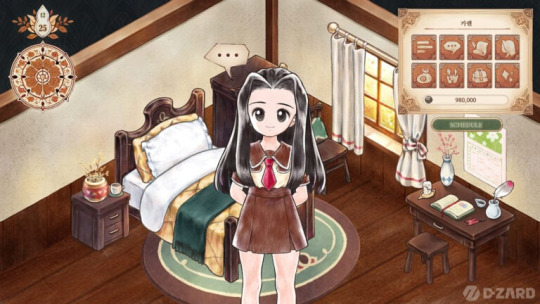
—Karen, Age 10
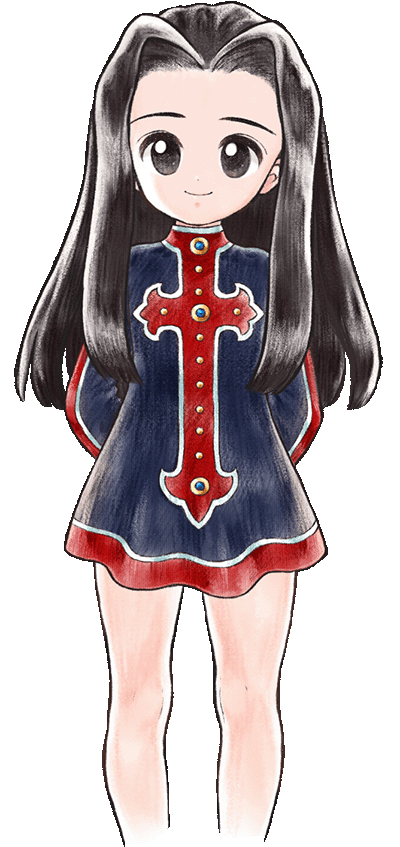
—Karen, Age 11
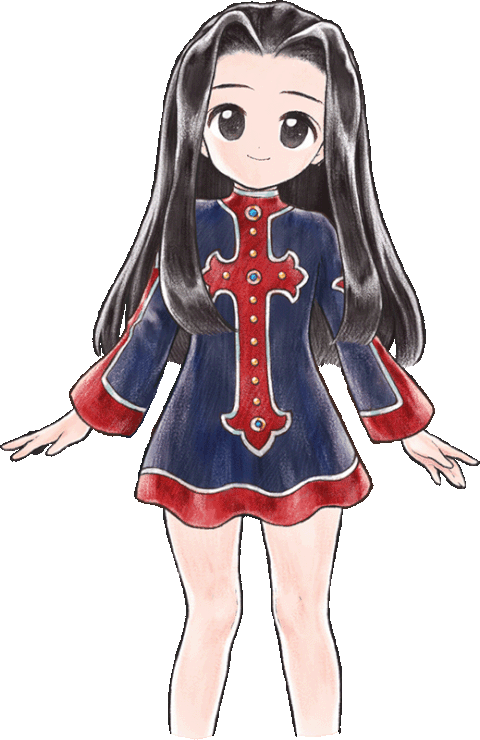
—Karen, Age 12
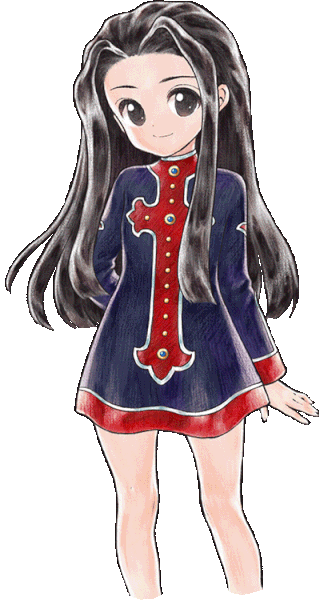
—Karen, Age 17

New and Returning Characters
The popular Butler character Cube will also make a return, assisting the player in managing the daughter’s schedule and raising her.
—Returning Character Cube: “You seem to be in a good mood today, milady.”
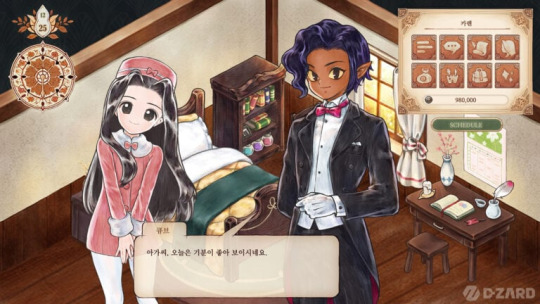
In addition to these returning characters, the game will also feature charming new NPCs designed by D-ZARD, who will play various roles in the daughter’s growth.
—New NPC Chef: “There’s a dish I want to make for you, before the season changes.”
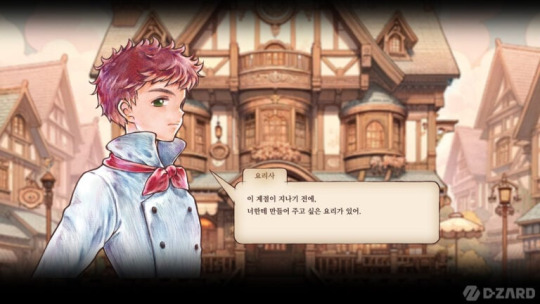
For Long-Time Fans and Newcomers Alike
The new game is being developed to be faithful to the series’ roots, with a fairytale-like atmosphere and various raising simulation elements. In particular, the game will maintain the tradition of the daughter’s appearance changing as she ages, while adding Live2D animation to the character’s poses to raise the bar even further.
—Vacation Scene

“We want to make a game that can meet the expectations of the fans who have been waiting a long time for a new Princess Maker game. We are doing our best to make a quality game that will appeal to both long-time fans and newcomers alike,” said D-ZARD CEO Dong-hyun Kim.
—Possibly an Ending Illustration?
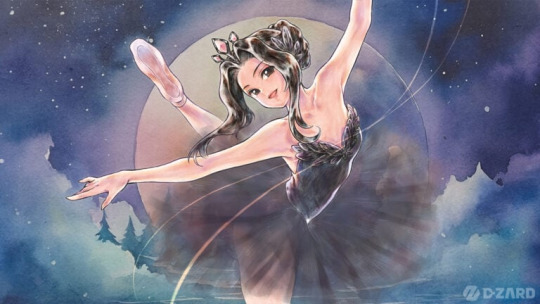
View the first images at the gallery.
#Princess Maker 6#Princess Maker#D-ZARD#Gainax#YONAGO GAINAX#simulation game#Gematsu#Was not expecting to see a new Princess Maker game in the works#gif
62 notes
·
View notes
Text

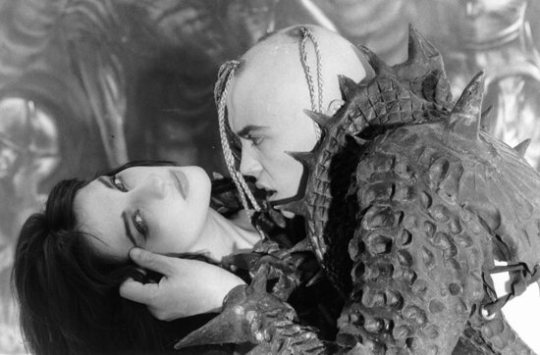

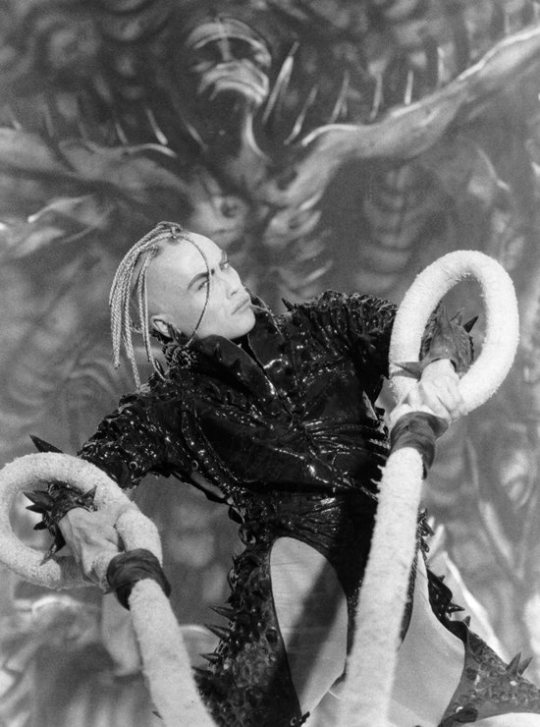

Meat Beat Manifesto
It was Craig's initial work as concept designer for Meat Beat Manifesto that prompted him to develop the qualities of his latex costumes into a commercial range of products.
Meat Beat are sighted to be one of the most influencial bands in the music scene to date.
Their ground breaking music teamed with the energetic choreography and the visually arresting stage and costume set proved to be outstanding.
A version of the Meat Beat Classic,' Babylon', is now residing on the new Prodigy Release.
Meat Beat was formed in 1988 and dis-banded in 1991.
The original line-up did well over 700 dates worldwide. There stage and live performances were radical, their music at the cutting edge. Meat Beat comprised of Jack Dangers, Writer and performer Piranna Jones, (AKA Marcus Adams), concept coreographer/performer Craig Morrison concept designer.
It was Craig's initial work with Meat Beat Manifesto that led to the product range of today.
'The Musician's musician' - NME 1990.
78 notes
·
View notes
Text

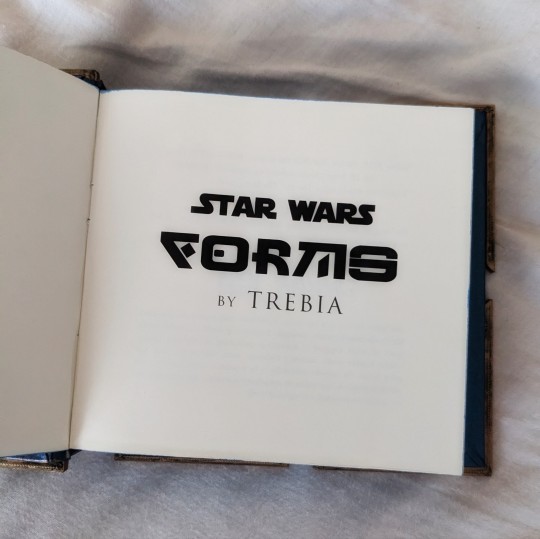

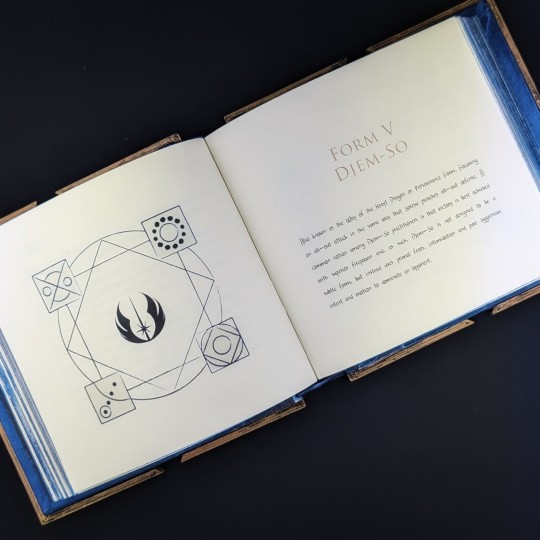

Binder's Note for Forms by Trebia
How Forms fits in the long tradition of Star Wars fanfic.
My hope is that this project captures a snapshot in time from Star Wars fandom het shippers between December 2015 and December 2017, before the franchise confirmed any emotional intimacy—if you can call it that— between Rey and Kylo Ren in Star Wars: The Last Jedi (2017).
Trebia, then aged 24, wrote and published the first chapter of Forms on Archive of Our Own on December 18th, 2015—the exact release date of Star Wars: The Force Awakens. When posting this first chapter, Trebia noted, “I’m just working off of memory from the one viewing I saw last night.” The entirety of the fanfic was completed and posted an exact month later, making this fic historically significant in Star Wars fandom as one of the earliest published “Reylo” stories.
A serialized novella that was churned out in an astonishingly short time frame, Forms is notable for predicting many elements of The Last Jedi (2017) and The Rise of Skywalker (2019), including the Reylo Force bond, Rey walking away from her training with Luke Skywalker, Kylo Ren pleading with Rey to join him, and Kylo Ren pushing his Force energy into Rey to save her life.
Throughout the story, Trebia mashed new and old Star Wars elements together—characters like the Mandalorians and Admiral Daala, settings like Illum and Kuat—evincing her fondness for the Galaxy Far, Far Away. Forms has classic tropes from this franchise, like stealing a uniform to go undercover in an enemy base and the forced proximity of a “Slow Boat to Bespin.” Present in Forms are scads of fan theories from between the release of The Force Awakens and The Last Jedi. These included the theory that—echoing a Legends plot line from Dark Empire (1991) where somehow Palpatine returns and Luke Skywalker joins the dark side to try and take him down from the inside—Kylo Ren had strategic reasons for his apprenticeship to Snoke. Like many Reylo fan-works set in-universe, Trebia lends justification to his many antisocial acts, part of shipper efforts to make the character more self-relevant and sympathetic.
Forms weaves in tantalizing threads that were tossed around by fans and concept artists but ultimately not pursued, including Dark Rey, Stormpilot (Finn/Poe Dameron), and Rey's saberstaff. Trebia even predicted the Kuat Drive Yards plot line started in The Last Jedi (Rose Tico’s contempt for weapon's manufacturers on Canto Bight) and continued in the abandoned Episode IX: Duel of Fates script by Colin Trevorrow. Forms also addresses loose ends that probably should have been covered for a more cohesive nine film saga, like the Chosen One prophecy and direct interaction between Anakin Skywalker and Kylo Ren.
No discussion of Forms can be complete without also placing it in the context of Star Wars fandom in 2016. Reylo was a fringe pairing that made intuitive sense to many Star Wars fans, particularly women; however, prior to The Last Jedi, the ship was dwarfed by the popularity of slash ships like Finn/Poe and Kylo Ren/Hux. At the time, many fans theorized that Rey was Luke Skywalker’s long-lost daughter, making her Ben Solo’s first cousin, making Reylo an incest ship.
As noted on the Fanlore wiki, the tags on this fic changed over time. In addition to “Riding the bus to hell either way” Trebia joked with tags like “Possible incest?” and “Not incest until proven guilty in the court of law.” Following the release of Star Wars: The Last Jedi, Trebia celebrated by replacing those tags with a celebratory “IT AIN’T INCEST.”
The story's strong influence in early Reylo fandom reflected a hunger for more Star Wars romances about the pull between light and dark. After all, the sequel trilogy did not set up Kylo Ren as a horned, alien-appearing monster or a wrinkled geezer. Unblemished by the ravages of the dark side, Kylo Ren was depicted with pillow lips and a fabulous, voluminous coiffure unencumbered by his helm (which really should have flattened it to his scalp.) The groundwork for a lightsider/darksider romance was previously explored in other Expanded Universe stories. At the forefront of these were watered down lightsider/darkside romances like the tepidly written romance between Luke Skywalker and former Palpatine agent Mara Jade. Given Mara Jade was hardly a champion of the dark side, there was no risk of corrupting Skywalker. But the Expanded Universe also boasted stories that played with this dynamic, like the twisted connection between Fable Astin and Jaalib Brandl by Patricia A. Jackson for the Star Wars Adventure Journal (1994), the conflict between Jaina Solo and Zekk in Kevin J. Anderson's Young Jedi Knights (1996),or the passion between Darth Revan and Bastila Shan in Star Wars: Knights of the Old Republic (2003). In this respect, Forms and the rest of the Reylo fan fiction oeuvre continues the grand fan tradition of Star Wars villain fucking.
“Darksider and lightsider conflict is one of the most fascinating points of Star Wars,” Trebia said in 2016, when interviewed by Spencer Kornhaber for The Atlantic. “Rey and Kylo represent the fight to find the balance.” Yet, at the time, the fledgling “Reylo” ship was abhorred by affirmational Star Wars fans who despised the emphasis on shipping with a female gaze, as well as scorned by media commentators who found the ship to be “problematic.” In male-dominated, established fan spaces like Reddit and Jedi Council Forums, discussion of Reylo was effectively banned by moderators through the freezing of threads. In other fandom spaces like Twitter and Tumblr, discourse about Reylo mirrored larger purity culture. The ship became a convenient target for alt-right misogynists, and also for anti‑shippers concerned that the ship “romanticized abuse.” Productive and unproductive debate arose around media consumption construed as agreement or approval, whether a sympathetic Kylo Ren lends people to give more latitude to real-life white right-wing men with anger management problems (or if it's the other way around), and if shippers can tell the difference between a fictional antihero and the same dangerous thing in real life. Critiques of Reylo fandom also included the implicit racism inherent in the sidelining of John Boyega’s heroic character Finn in favor of white whiny fascist Kylo Ren. (It did not help that 2016 also saw the election where white American women voters decided to displace a competent Black man with a white whiny fascist.)
In the September 2020 issue of the Journal of Fandom Studies, Andrea Marshall notes that Reylo “fan fiction acts as a locus of resistance to gendered oppression as feminist authors construct selves that critique the source material and the fandom for gendered oppression within tropes and attitudes.” By having Rey actually interact with and befriend a woman other than Leia, Forms already improves on the source material. It's a delight to see Forms depict older women over age fifty who are plot-significant and interact which one another, if only because Star Wars movies are fairly gender regressive. On the other hand, Rey's strategy to convert Kylo back to the light is to uh, suck the badness out of him. It's Padmé Amidala logic—sure, he arranged the wholesale slaughter of an entire village, but he can also deftly finger you to orgasm! Granted, Star Wars is infamously a franchise of excuse making, where really shitty dudes manage to turn it around and do the right thing at the last minute. Forms also doesn't push all that hard to actively resist the neo-fascist allegory in the sequel trilogy, particularly in Trebia's appendix, which dissatisfactorily explains that all of the First Order war criminals in the story ended up as instructors in military academies. (Who would even hire them, Albus Dumbledore?!)
Fics like Forms led to “ship wars” discourse, which led to the publication of ozhawkauthor's “The Three Laws of Fandom” meta essay on January 1st, 2016. “Laws” is a bit of a misnomer since there is no enforcement body; the essay is more of a request for courtesy in fandom spaces. The laws were also meant to apply specifically to shipping, not fandom or media criticism as a whole. “It’s not up to you to decide what other people are allowed to like or not like, to create or not to create,” wrote ozhawkauthor. “That’s censorship. Don’t do it.”
For fans conscious of fandom history and the impact of censorship in spaces like FanFiction.net and Livejournal, ozhawkauthor's guidelines—(1) Don't like; don't read, (2) Your ship is not my ship, (3)Ship and let ship—felt intuitive. This is reflected in spaces like my bookbinding guild, Renegade, which—similar to Archive of Our Own—takes a hands off approach to policing content. This did not prevent widespread handwringing about Reylo content. Star Wars fan ughwhyben reflected on the “gigantic fandom that is suddenly experiencing a renaissance, where an influx of mainstream folk are trickling into (or running into) the fic side for possibly the first time right now and don’t have this training. It’s like we’re flickering back and forth between the modern evolution of fic side fannish culture and what things were like in, for example, 2001 when I first stumbled in.”

Decades ago, in May 1981, Lucasfilm reacted to the publication of “Slow Boat to Bespin” by Anne Elizabeth Zeek & Barbara Wenk by declaring a ban on smut in fan fiction. I've included in the errata of this binding a letter from 1981 written by the Star Wars fanclub president to circulating fanzines threatening legal action. While slash was also caught in this net—disproportionately targeted given non-explicit gay romance was not okay even though Star Wars has non-explicit het romance—it was this fairly tame (by fic standards) heteronormative fic, featuring Han Solo and Princess Leia, that signaled to Lucasfilm that smutty fanfic was no longer on the fringes and now needed to be addressed to protect the “wholesomeness” of the franchise. Subsequently, fanfic writers had to make a conscious decision to flout Lucasfilm’s policy and go forth with propagating their smut.
And, in 2016, of all the ships in all of fandom, it was the Reylo Star Wars pairing, featuring this specific heteronormative female power fantasy (of being able to leash a villain by the dick to drag him back to the light) that led to a communal reaffirmation of these fandom norms. In her interviews with the The Atlantic, Trebia directly quotes from the Three Laws of Fandom, endorsing “ship and let ship” as a basis for creating Reylo fanworks. “I am fully involved in the garbage compactor that is this pairing, and I love it,” Trebia said. “No matter what way it goes, I will stick with it.”
After studying early romance novels from the late 1600s and early 1700s, Ros Ballaster observed a polarity between didactic love fiction and amatory fiction. Didactic love stories are sweet—aspirational, moral, and idealized—while amatory fiction is spicy—erotic, transgressive, untethered from social sanction. We do see representations of didactic love in Reylo fan fiction, particularly in contemporary romance “Modern AUs” like Ali Hazelwood's The Love Hypothesis (2021)where the Kylo's homicidal Sith rage is sanitized to a more socially-acceptable grumpy academic brooding. One can comfortably bring Adam Carlsen, Ph.D home to meet Mother. But certainly, the majority of Reylo fic written by fans gravitate towards and come with the self awareness of the amatory. For one, Trebia loudly proclaims in her Chapter Two author note: “MORE TRASH FOR THE TRASH GOD.”
Discourse over the “morality” of Reylo fan fiction tends to overlook the distinction between the didactic and the amatory. As compelling as the idea of a “Force dyad” is in fantasy, this relationship is not meant to be aspirational in a literal sense. Yet, readers of Reylo fiction were and continue to have to defend their interest in the archetype with disclaimers—yes, it's trash, yes, I know it's problematic—while men in fandom are not held to the same standards when it comes to “problematic” media they consume or enjoy, whether it's a Michael Bay blockbuster film or male-gaze pornography.
As Deborah Lutz notes, “The Dangerous Lover Romance” is a centuries old, conventional way to represent erotic desire and romantic love. The “sublimely tormented Byronic hero” is hardly groundbreaking, to the extent that Rian Johnson's depiction of Reylo in The Last Jedi subverts the trope—at the end of the film Rey isn't enchanted, she's repulsed. The same way Star Wars replicates Joseph Campbell's Hero's Journey monomyth, Reylo stories like Forms reflect the broad appeal of the “how-the-turntables” Dangerous Lover romance—where the woman protagonist, initially subjugated by the debased, restless misanthrope, ends up subjugating him through her strength of will and the power of love. Trebia's Kylo even sports malevolent scars like so many Gothic male romantic leads before him—always on the face. In the Gothic romance, the heroine accesses socially undesirable aspects—power, rage, craving, desire—as expressed by her double, the Dangerous Lover. His presence in the story provides a basis for her disinhibition. The Reylo ship follows a well-trodden cultural script of transgressive female desire.
Forms the fan fiction novella is a notable cultural artefact reflecting a distinct period of time in Star Wars fandom. At the time, Reylo fanfic held all the promise of improved representation for women characters, crossed with the instinctual, regressive insistence that maintains a white male character in the forefront. Reylo fan fiction produced in early 2016 also led to the reification of anti-censorship values in fandom. Seven years later, a fandom that was once derided has gone fully mainstream, as fic writers like Ali Hazelwood, Ashley Poston, and Thea Guanzon top traditional publishing bestseller lists. What Trebia knocked out, hours after her introduction to the characters, is now it's own Star Wars literary tradition.
#fanbinding#bookbinding#reylo#reylofanfic#fanfic binding#ficbinding#star wars history#holocron#jedi holocron
43 notes
·
View notes
Audio
Extreme Noise Terror - Another Nail In The Coffin
#Extreme Noise Terror#A Holocaust in Your Head#Another Nail In The Coffin#Release date: 1991#90's#90s#Full-length#Genre: Crust/Grindcore#Lyrical themes: Anti-fascism Animal rights#UK
29 notes
·
View notes
Text
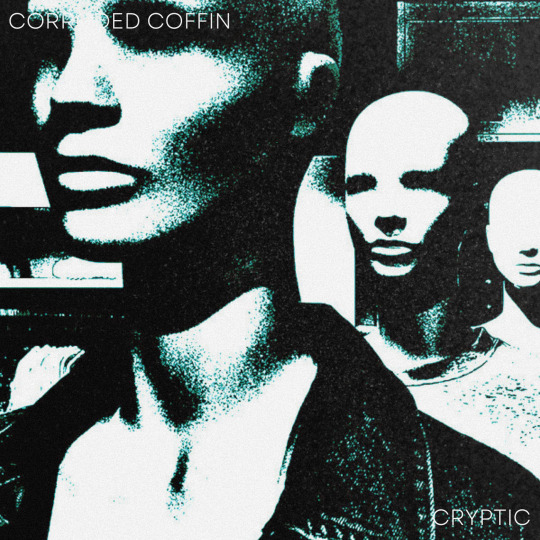

Corroded Coffin, Cryptic (1991)
After the release of their record-breaking debut album, Corrosion, expectations of Corroded Coffin's next record were high, to say the least. It is, after all, not often that we get to see a new artist climb its way up the ladder of success as smoothly as we saw it happen in '88. The band's debut dominated not just the Rock charts, positioning the rookies comfortably among the greats of Guns 'n Roses, former Beatles and even Michael Jackson. All this accumulated into one of the best-selling albums of the year and ended award season with three Grammy nominations the next year. On top of that, their Corrosive Damage Tour grossed over 20 million dollars, nearly selling out every date on the roster.
Thus, when the band released their single "Unnamed," immediately hitting the top 10 on nearly every chart, everything seemed to be heading in the same direction for the band's sophomore project Cryptic.
Unfortunately, that does not seem to be the case.
It is natural for artists to want to out-do themselves, fearing to be seen as a one-trick pony, but in the case of Corroded Coffin, that came to be a self-fulfilling prophecy. The musicians' need to proof their skills and range, resulted in a incoherent collection of songs that veer too far off from what their fans had grown to love in the first place.
When asked about what they thought of the album, one fan said: "I don't know what I just listened to, but [Corroded] Coffin it ain't."
"They better get their shit together, because I'm not paying money to see this crap live," another listener exclaimed.
Experimentation is always encouraged in the music industry, as is re-invention, but there is a time and place for it, and for a band that has only released one prior record, that time was not now. All choices made in the production, from the voice filters to a new peculiar guitar style, seem to have come from a clear place of insecurity, in particular in the band's frontman, Eddie Munson.
That is now surprise however, as prior to the release of Cryptid, Munson had already been quoted to voice his concerns on several occasions. When on air with Jackie deLange from HRM.FM last December, the singer/guitarist talked of the fears that come with a hit release such as Corrosion:
"The second Corrosion started rising the charts, the only question on everyone's mind was What's next? And shit if I know. We never expected to get where we are now with this record. It was made in a toilet of a studio on a barely existent budget, if you can call it that. The odds we're certainly not in our favour and I still don't know how we managed to pull this off. [...] It's deffinitely an immense amount of pressure for someone that barely graduated high school. I don't know if I can do anything as well as that, but I can for sure try."
The quote also begs to question, is the real problem behind the lack of further success the amount of recources available to them under the new label? Having signed on to Black Widow Records mid-tour, the band gained access to equiptment and people unimaginable to unsigned nobodies as they were while creating their breakout hits. Such a change must have been overwhelming, and while it can bring a new form of freedom to the process, it also clearly creates a much larger area for mistakes.
Either way, I hold out hope that it was nothing but a hiccup in the discography, and that the band will come to realise what makes their style theirs and grow with it, but for now the album will remain a reminder for us all that you must learn to walk before you can run.
- The Corroded Coffin Archive (Source: Metal Edge)
#eddie munson#corroded coffin#eddie munson fanfiction#eddie munson edit#edit#eddie munson blurb#eddie munson fic#fanfic#fic#rockstar!eddie
39 notes
·
View notes
Text
Tuxedo Mask's roses were Takeuchi's idea
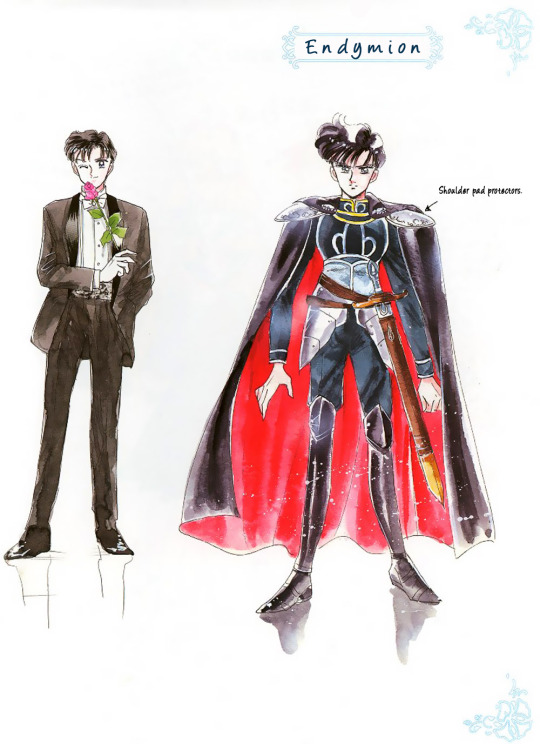
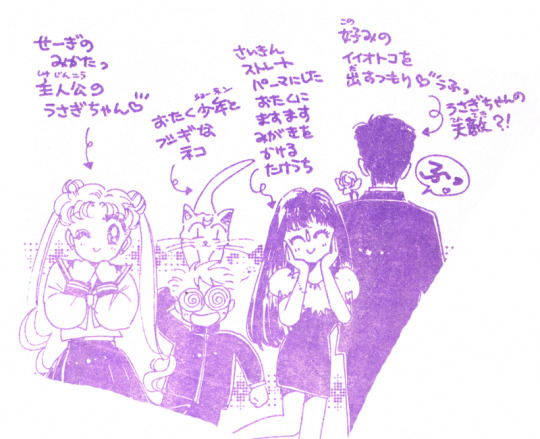
TOP: A page from the Sailor Moon Materials Collection which includes various early draft notes from Naoko Takeuchi.
BELOW: An excerpt from the January 1992 issue of Nakayoshi features a number of ads for Pretty Soldier Sailor V, which at one point was the working title of what eventually would become Sailor Moon. Note how the cat in the image is distinctly white, like Artemis, rather than black like Luna. You will also note the dark haired guy with his back turned is carrying a rose. The text connected to him reads something like:
A good-looking guy who's my type, could he be Usagi's sworn enemy?!
Remember, in the manga, Tuxedo Mask's alignment is questioned as early as chapter 4, where Luna and the others are uncertain if he is friend or foe.
Sailor Moon Chapter 1 was finally published in the February issue of Nakayoshi btw, so the change was apparently very last minute. However, the actual release date was 28 December 1991, with the anime episode adapting this chapter going out on 7 March 1992, a incredibly fast production period.
Evidently, the idea of Tuxedo Mask using a rose as his signature weapon was something Takeuchi was toying with and had in mind enough that the anime committed to it before she changed her mind.
#sailor moon#tuxedo mask#mamoru chiba#chiba mamoru#usagi tsukino#tuxedo kamen#naoko takeuchi#nakayoshi#bishojo senshi sailor moon
52 notes
·
View notes
Text
"space case": the pre-2005 martin jordan
these days the quintessential hal jordan is easily defined by two traits: a distinct lack of fear, and a penchant for wearing his father's air force jacket. hal's father is his hero, you all know that. or, that's what you've been led to believe by the post-2005 geoff johns era of green lantern that has completely overshadowed everything that had come before and worked hard to erase the slightest hint of friction between hal & his father.
first things first, the post-2005 continuity can be looked at as half a fanboy's wish and half editorial mandate -- the biggest inspiration for hal's hero worship of martin (+ the whole deal with his jacket) and his overall attitude comes from darwyn cooke's elseworlds dc: the new frontier 2004, its unparalleled commercial success was undoubtedly a leading factor in the changes that followed and cooke had once spoken about being asked to work on green lantern secret files and origins 2005 (the one-shot that would jumpstart the 2005 ongoing series after the rebirth miniseries) for precisely that reason.

(graphic ink: the art of darwyn cooke)
secondly, for thirty (count 'em!) years of hal jordan's existence there had been no mention of his parents whatsoever. he had brothers, cousins, uncles come in and out of his life throughout green lantern 1960 but never parents. that all changed in 1989 with green lantern: emerald dawn #1, the first real attempt to give hal an origin (see below).
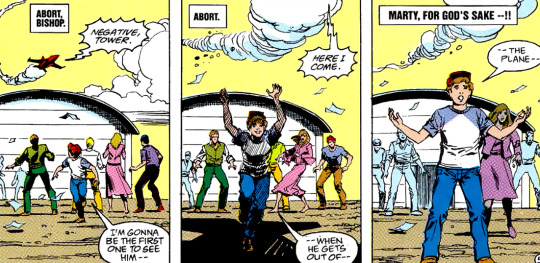
lastly and most importantly, martin had undoubtedly been an abusive father to hal and remained one of his few deep deep actual fears.
i'll be your guide through these pre-2005 appearances and mentions of martin and his relationship with hal, presented in chronological order based on real life release dates rather than internal chronology.

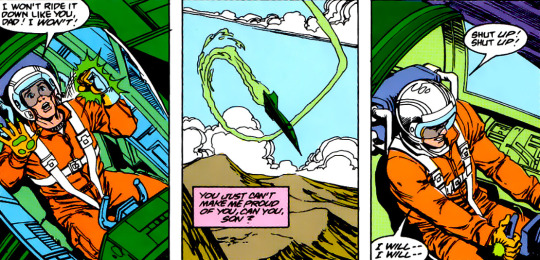
("you just can't make me proud of you, can you, son?" emerald dawn 1989 #2)

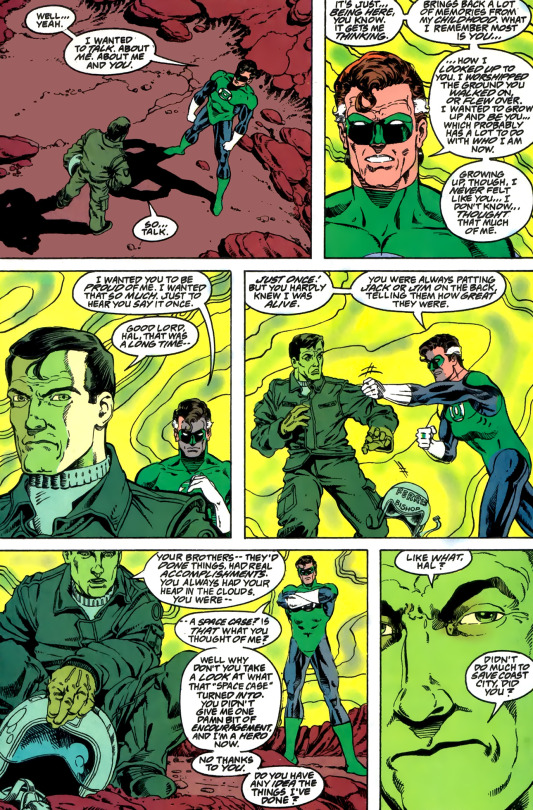
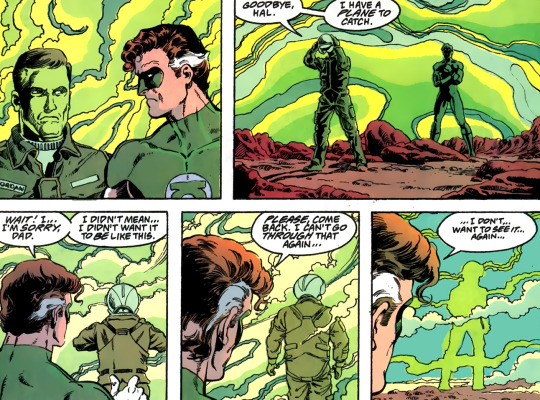
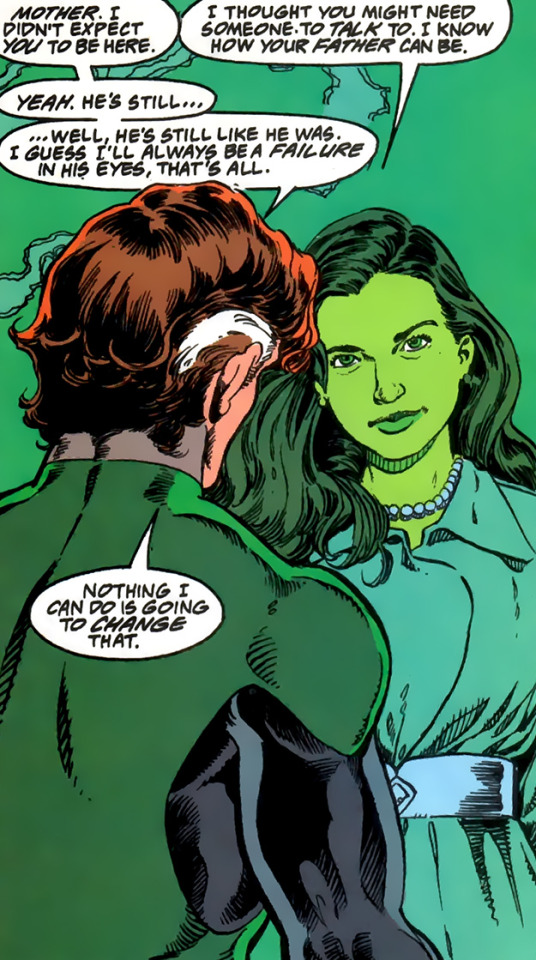
("well, he's still like he always was. i guess i'll always be a failure in his eyes, that's all. nothing i can do is going to change that", green lantern 1990 #48, published 1994)

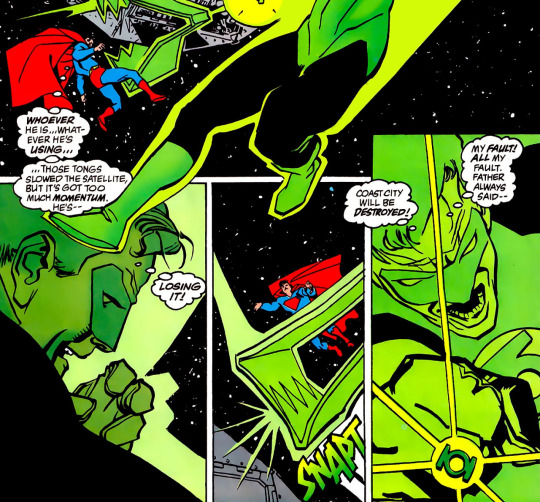
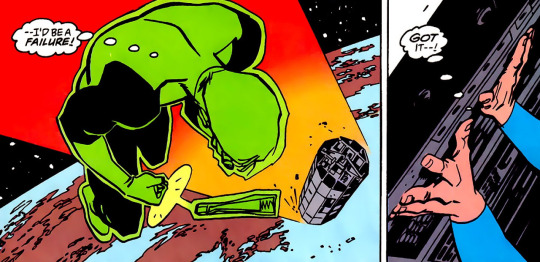
("my fault! all my fault. father always said i'd be a failure!", superman: the man of steel (1991) annual #4, published 1995)
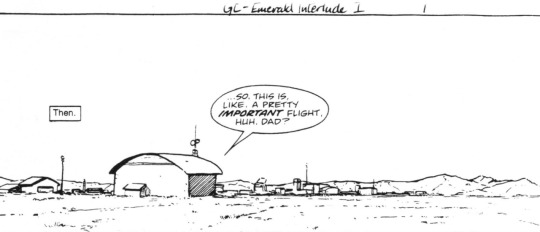
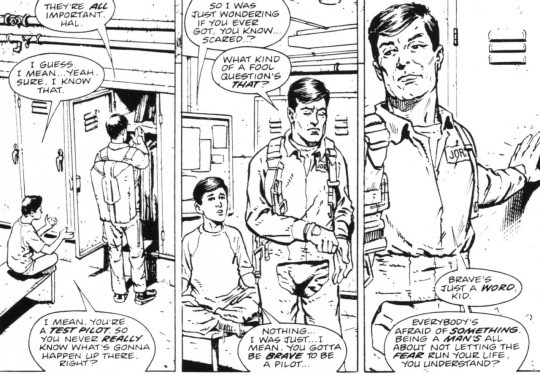

("the problem with you, hal, is you always got your head in the clouds", unpublished 'emerald interlude' originally slated for legends of the dc universe 1998 #33)

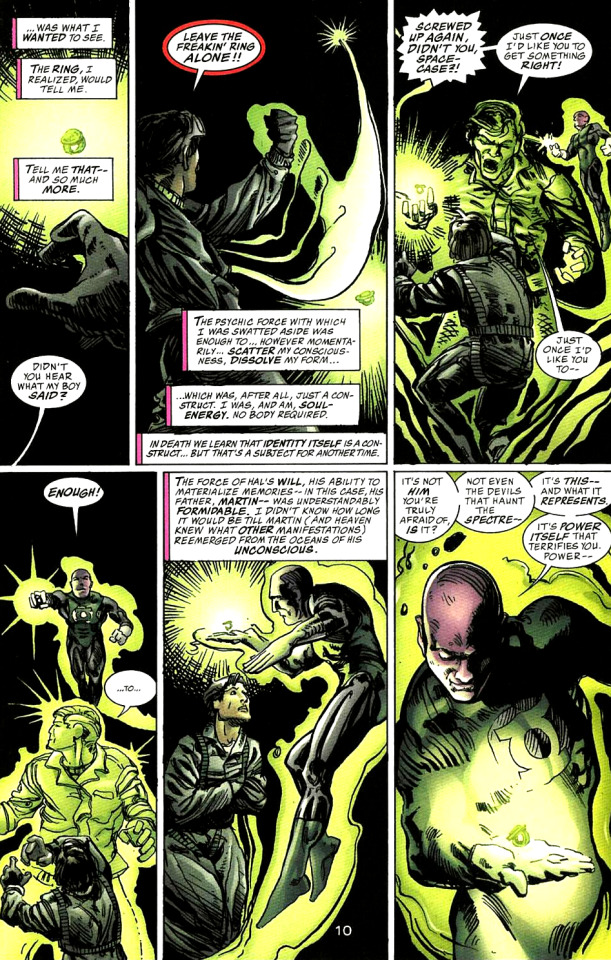
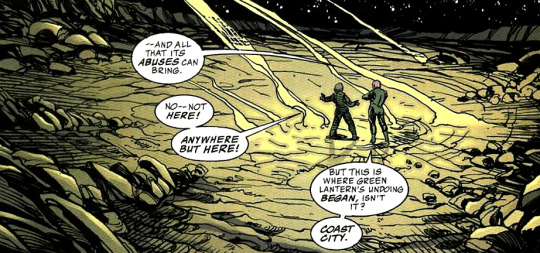
("screwed up again, didn't you, space-case?! just once i'd like you to get something right!", legends of the dc universe 1998 #35, published 2000)




("you become what you know. and what you didn't know you knew. like what you learn at the end of someone's arm. you learn to go blank. like maybe things with him would change if you could just give him what he wants. if you could just take it like a man", dc comics presents: green lantern 2004 #1)
interestingly enough, each of these stories is the work of different writers and between legends of the dc universe and dc comics presents: green lantern the narrative woven throughout becomes explicit -- hal perceives martin's abuse as abuse of power first and foremost, and doesn't just fear becoming 'what he knows' but also fears that he already did by abusing the power of the green lantern as parallax. all in all, it's an incredibly complex narrative seldom afforded to superheroes nowadays and an entirely vital part of hal's characterisation that we've been robbed of for far too long now.
#hal jordan#martin jordan#green lantern#abin sur#oliver queen#green arrow#superman#clark kent#green lantern corps#glc#justice league#justice league of america#jla#dc#dc comics#u can reblog#cw child abuse#very rushed hope its readable. had to get it out there
126 notes
·
View notes
Text
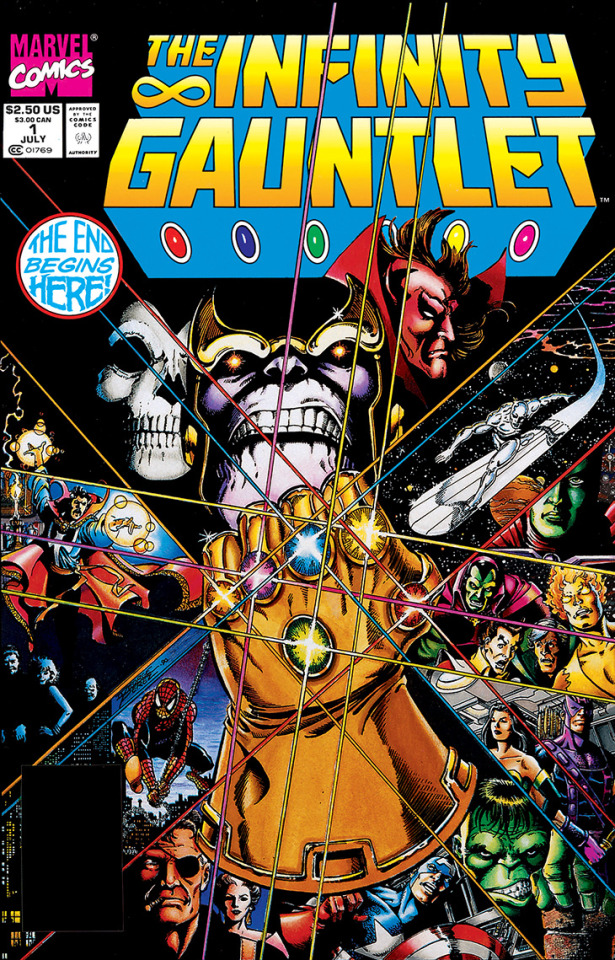
The end begins here! On this date in 1991, Marvel released Infinity Gauntlet #1 by Jim Starlin and George Perez. Featuring Thanos and his never-ending quest to catch the eye of Death, the Mad Titan assembled his gathered Infinity Gems and produced the SNAP! that was heard by, well, at least half the universe ...
19 notes
·
View notes